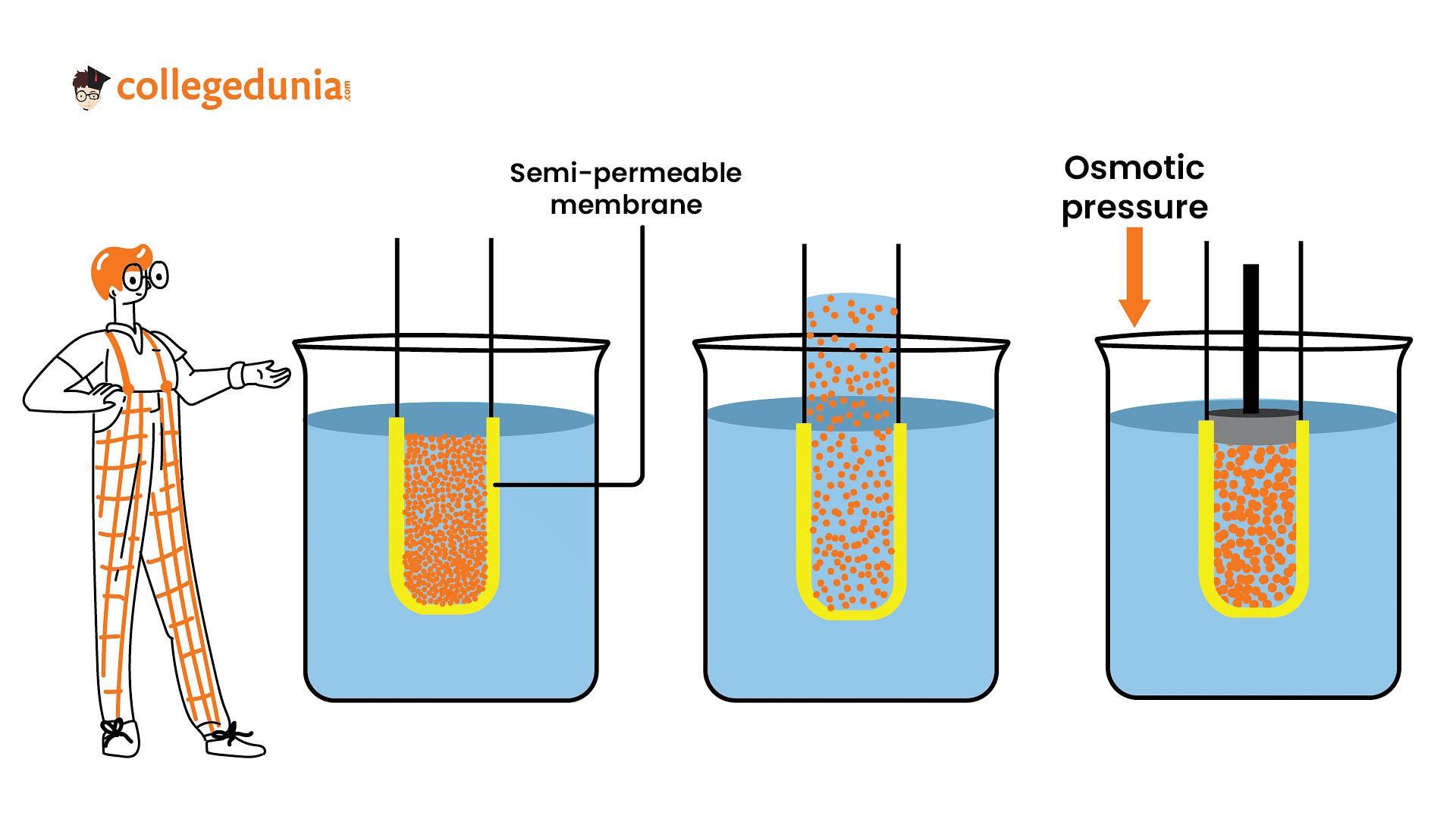Osmotic pressure can be increased by
Show Hint
Osmotic pressure describes the pressure exerted by a solvent to prevent the influx of solvent molecules through a semipermeable membrane
- increasing the temperature of the solution.
- decreasing the temperature of the solution.
- increasing the volume of the vessel.
- diluting the solution.
The Correct Option is A
Approach Solution - 1
Osmotic pressure is directly proportional to the temperature $\because \pi=CRT$ where,
- C= concentration
- R= gas constant
- T= temperature
i.e. $\pi \propto T$, thus, on increasing the temperature, osmotic pressure also increases.

Discover More From Chapter: Solutions
Approach Solution -2
Osmotic pressure describes the pressure exerted by a solvent to prevent the influx of solvent molecules through a semipermeable membrane. The temperature of a solution has a significant influence on its osmotic pressure.
Temperature and Molecular Kinetics
- Temperature is a measure of the average kinetic energy of molecules in a solution.
- An increase in temperature corresponds to an increase in molecular kinetic energy.
Effect of Temperature on Solvent-Solute Interactions
- When the temperature of a solution increases, the kinetic energy of solvent and solute molecules increases as well.
- This increased kinetic energy leads to more frequent and energetic collisions between solvent and solute particles.
Read More:
| Related Concepts | ||
|---|---|---|
| Spore Formation | Vegetative Bud | Electroosmosis |
| Amoeba | Binomial Nomenclature | Cell Wall and Cell Membrane |
Enhanced Solvent-Solute Interaction
- As the temperature rises, solvent molecules gain energy to overcome intermolecular forces.
- This enhanced interaction increases the rate of solvent molecules crossing the semipermeable membrane.
Increased Movement of Solvent
- With higher temperatures, solvent molecules move more rapidly, resulting in a greater tendency to move across the membrane.
- Consequently, the osmotic pressure of the solution increases due to the greater flow of solvent molecules.
Relationship Between Temperature and Osmotic Pressure
- Increasing the temperature of a solution increases the kinetic energy and movement of solvent molecules.
- This increased movement elevates the osmotic pressure, as more solvent molecules attempt to equalize the concentration on both sides of the semipermeable membrane.
The temperature of a solution plays a crucial role in its osmotic pressure. Increasing the temperature leads to enhanced molecular movement and more vigorous solvent-solute interactions, resulting in an increase in osmotic pressure.
Top Questions on Solutions
- 10 mL of 2 M NaOH solution is added to 20 mL of 1 M HCl solution kept in a beaker. Now, 10 mL of this mixture is poured into a volumetric flask of 100 mL containing 2 moles of HCl and made the volume upto the mark with distilled water. The solution in this flask is :
- Which of the following is not a colligative property?
- BITSAT - 2025
- Chemistry
- Solutions
- How much water must be added to 500 mL of 2 M $ \mathrm{H_2SO_4} $ solution to make it 0.5 M?
- BITSAT - 2025
- Chemistry
- Solutions
- The pH of a solution is 3. What is the concentration of hydrogen ions in this solution?
- BITSAT - 2025
- Chemistry
- Solutions
- What is the pH of a solution with [H\(^+\)] = 10\(^{-3}\) M?
- BITSAT - 2025
- Chemistry
- Solutions
Questions Asked in KCET exam
A block of certain mass is placed on a rough floor. The coefficients of static and kinetic friction between the block and the floor are 0.4 and 0.25 respectively. A constant horizontal force \( F = 20 \, \text{N} \) acts on it so that the velocity of the block varies with time according to the following graph. The mass of the block is nearly (Take \( g = 10 \, \text{m/s}^2 \)):

- KCET - 2025
- work, energy and power
- Given, a current carrying wire of non-uniform cross-section, which of the following is constant throughout the length of the wire?
- KCET - 2025
- Current electricity
- If the number of terms in the binomial expansion of \((2x + 3)^n\) is 22, then the value of \(n\) is:
- KCET - 2025
- Binomial theorem
- Ethyl alcohol is heated with concentrated sulphuric acid at 413 K (140°C). The major product formed is
- KCET - 2025
- Organic Chemistry
- A body of mass 0.25 kg travels along a straight line from \( x = 0 \) to \( x = 2 \, \text{m} \) with a speed \( v = k x^2 \) where \( k = 2 \, \text{m}^{-1} \). The work done by the net force during this displacement is
- KCET - 2025
- Elastic and inelastic collisions
Concepts Used:
Solutions
A solution is a homogeneous mixture of two or more components in which the particle size is smaller than 1 nm.
For example, salt and sugar is a good illustration of a solution. A solution can be categorized into several components.
Types of Solutions:
The solutions can be classified into three types:
- Solid Solutions - In these solutions, the solvent is in a Solid-state.
- Liquid Solutions- In these solutions, the solvent is in a Liquid state.
- Gaseous Solutions - In these solutions, the solvent is in a Gaseous state.
On the basis of the amount of solute dissolved in a solvent, solutions are divided into the following types:
- Unsaturated Solution- A solution in which more solute can be dissolved without raising the temperature of the solution is known as an unsaturated solution.
- Saturated Solution- A solution in which no solute can be dissolved after reaching a certain amount of temperature is known as an unsaturated saturated solution.
- Supersaturated Solution- A solution that contains more solute than the maximum amount at a certain temperature is known as a supersaturated solution.